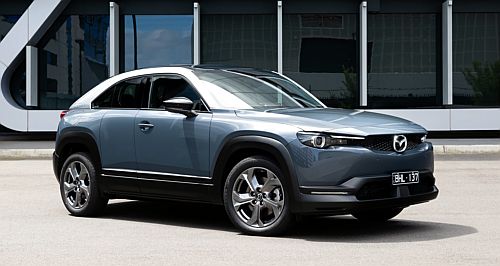Make / Model Search
News - Mazda - CX-30 - eWhat Mazda learnt from the MX-30 EVMazda’s niche first electric car had a value beyond its meagre sales30 Oct 2024 By SCOTT NEWMAN The Mazda MX-30 was announced as leaving the Australian market in October, 2023, and as the last examples are sold the company was asked to reflect on the vehicle, in particular the electric version that made up less than five per cent of the 2482 sales.
Was Mazda’s first electric car a failure?
“No, it was great for dealer training and dealer focus,” said Mazda Australia Marketing Director, Alastair Doak.
“We knew that we were getting plug-in hybrids, and even mild-hybrids, but plug-in in particular, so we were very open for all of the dealers to invest in that infrastructure, to be able to charge at their dealership, but also have technicians that could work on the cars, you have to do high voltage training. So that was a real rallying cry, it gave us a point of ‘well, this thing’s coming, you need to do X’, so from that point of view it worked perfectly.”
The dice was stacked against the MX-30 E35 Astina, as the electric version was known, due to not only its high price ($66,560 plus on-road costs) and limited 224km range but its unique body style, which featured a coupe roofline and RX-8-style rear-hinged back doors.
“It was a nice car,” said Doak. “I think it’s proven once again the Australian buying public are quite practical and conservative in their choices. We’ve seen it over the years with other brands as well which bring in things to this country that have done well overseas, very trendy cars, and then they come here and everybody goes ‘That’s probably a wee bit too far in terms of design or whatever’.”
The MX-30 EV attracted headlines when dealers slashed prices by up to $15,000 in an attempt to clear stock, but Doak said outright sales were never the object. “Obviously, it was a niche product. The (MX-30) was niche to begin with and then you had the EV part, which, back then, was even more niche than it is now.
“We got our goal. We always had very realistic volume on it; we brought in 100 and it took us a while to get through those but we did. Really, for us, it was the dealer focus. In terms of customer feedback, the people who love the car love the car. I don’t think there was much anything else beyond that, but it did a really good job of getting us kind of match fit.
The next stage of Mazda’s electrification journey has been the introduction of mild-hybrid and plug-in hybrid technology in its CX-60, CX-70, CX-80 and CX-90 SUVs. The brand has stated that by 2030 100 per cent of its range will be electrified, with at least 25 per cent being pure-electric.
“For some time, Mazda has been saying by 2030 in the global portfolio we will have battery EVs, plug-in hybrid, full hybrids, mild hybrids (and) range extenders,” said Vinesh Bhindi, Mazda Australia’s Managing Director.
“All of those technologies will be available and from our point of view, we will have most of those available to us. Which cars, which models, it’s probably not the day to share those, (but) our view is we always will meet the market for all of those segments we compete in and bring the appropriate technology as it evolves.
 |
Click to shareMazda articlesResearch Mazda Motor industry news |









Facebook Twitter Instagram